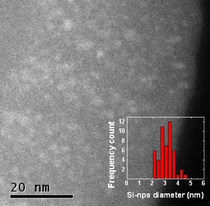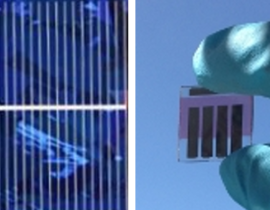« Main Page » : différence entre les versions
Aucun résumé des modifications |
Aucun résumé des modifications |
||
| (22 versions intermédiaires par un autre utilisateur non affichées) | |||
| Ligne 1 : | Ligne 1 : | ||
[[fr:Accueil]] |
[[fr:Accueil]] |
||
{| |
{|border="0" |
||
[[File:Bandeau news MaCEPV becomes MatISEn.png|x150px|link=https://matisen.icube.unistra.fr/en/index.php/News |News]] |
|||
| ⚫ | |||
{|style="color: #4392D8;" width="100%" |
|||
| style="width: 10%; | |
|||
''<big>'''<big>Research activities of MatISEn team</big>'''</big>'' |
|||
| ⚫ | |||
The activities of the '''MatISEn team''' are at the interface between the '''physics of electronic materials''' and the '''development of elementary semiconductor devices'''. They are based on the team's multidisciplinary skills in the '''development of thin films''' by physical or chemical methods, and in the '''fabrication and advanced characterization of electronic, photovoltaic or optical devices'''. <br> |
|||
Our work aims to better understand the physical mechanisms governing the growth of nano-structured thin films, to modify materials by chemical or physical treatments and to study opto-electronic properties that have a strong impact on device operation (electrical conductivity, charge carrier mobility, band structure, absorption and emission spectra, etc.). The materials are generally designed to be integrated as an active element in elementary devices in order to improve their "performance" or to provide new functionalities. |
|||
<br> |
|||
The materials studied (since the creation of the team) are, among others, crystalline or microcrystalline silicon, metal oxides based on zinc or tin, nitrides, oxides and oxynitrides, ferroelectric inorganic perovskites, carbon materials such as graphene or Diamond Like Carbon (DLC), semiconducting polymers and molecular semiconductors. It should be noted that organic materials are developed in close collaboration with several teams of chemists and physico-chemists from local public laboratories which gave birth to the "Strasbourg electronic organic " consortium [http://stelorg.unistra.fr/ STELORG]. |
|||
{|border="0" |
|||
| |
| |
||
[[File: |
[[File:Imagetheme3.png|thumb|upright=0.7|gauche |link= Nanomaterials for electronics and sensors|[[Nanomaterials for electronics and sensors]]]] |
||
| ⚫ | |||
| ⚫ | |||
| ⚫ | |||
[[File:Macepv-faisceaux8.jpg|thumb|upright=1.1|gauche|link=Ion beam & photon assisted processes|[[Ion beam & photon assisted processes]]]] |
|||
| |
| |
||
| ⚫ | |||
|} |
|} |
||
The MaCEPV team is running multidisciplinary research activities ranging from the synthesis of materials with physical and chemical tools to the achievement of elementary devices (diodes, transistors, memories, solar cells), through the modeling of charge transport in such devices. More specifically, the investigations concern the development of innovative processes for wafer based silicon solar cells (multicrystalline, ribbon), the formation and characterization of ultrathin film silicon solar cells on foreign substrates, the synthesis and characterization of oxide/nitride based nanostructured materials for optoelectronics, the optimization of transistors and organic solar cells, the modification/synthesis of new materials by ion beams for the development of innovative electronic components, the development of models and simulation tools to study the charge transport in photovoltaic and electronic components.<br> |
|||
{| |
|||
The MaCEPV team owns advanced infrastructures such as two technological platforms (clean room, glove box), unique facilities for the synthesis of materials (ion implanters, lasers, CVD, sputtering), for structural analysis (RBS, ERDA, Raman ...) and for optoelectronic investigations (photoluminescence, spectral response, ...) in addition to setups for the analysis of devices. The Modeling activities rely on computers and simulation tools developed in-house or commercial software (Monte-Carlo, scripts, COMSOL Multiphysics, ...).<br> |
|||
<big> The team's work is organised into 2 main activities which are described in more detail below: </big> |
|||
The MaCEPV team is involved in numerous national (ANR, AMI...) and European projects (INTERREG, FP7, EUROGIA...) as well as in international collaborations (Kazakhstan, Belarus, Turkey ...).<br> |
|||
|} |
|||
The MaCEPV team activities are divided into three themes with quite strong interactions among them, namely:<br> |
|||
''T1. [[Advanced inorganic materials for photovoltaics]]''<br> |
|||
{|style="color: #4392D8;" width="100%" |
|||
| ⚫ | |||
| style="width: 10%; | |
|||
''T3. [[Ion beam and photon assisted materials and processes]]''<br> |
|||
<big> |
|||
| ⚫ | |||
*''2. [[Materials and photovoltaic components]]''<br> |
|||
</big> |
|||
|} |
|||
| Ligne 22 : | Ligne 44 : | ||
'''ICube UMR 7357 - Engineering science, computer science and imaging laboratory '''<br> |
'''ICube UMR 7357 - Engineering science, computer science and imaging laboratory '''<br> |
||
'''D-ESSP department - |
'''D-ESSP department - MatISEn team ''' <br> |
||
23, rue du Loess - BP 20 CR - 67037 STRASBOURG Cedex 2 - France <br> |
|||
Tel.: +33 (0)3 88 10 6328 |
|||
© 2013 ICube - Website created by ICube - [[Legal notice]] |
© 2013 ICube - Website created by ICube - [[Legal notice]] |
||
Dernière version du 19 mars 2024 à 14:31

|
Research activities of MatISEn team |
The activities of the MatISEn team are at the interface between the physics of electronic materials and the development of elementary semiconductor devices. They are based on the team's multidisciplinary skills in the development of thin films by physical or chemical methods, and in the fabrication and advanced characterization of electronic, photovoltaic or optical devices.
Our work aims to better understand the physical mechanisms governing the growth of nano-structured thin films, to modify materials by chemical or physical treatments and to study opto-electronic properties that have a strong impact on device operation (electrical conductivity, charge carrier mobility, band structure, absorption and emission spectra, etc.). The materials are generally designed to be integrated as an active element in elementary devices in order to improve their "performance" or to provide new functionalities.
The materials studied (since the creation of the team) are, among others, crystalline or microcrystalline silicon, metal oxides based on zinc or tin, nitrides, oxides and oxynitrides, ferroelectric inorganic perovskites, carbon materials such as graphene or Diamond Like Carbon (DLC), semiconducting polymers and molecular semiconductors. It should be noted that organic materials are developed in close collaboration with several teams of chemists and physico-chemists from local public laboratories which gave birth to the "Strasbourg electronic organic " consortium STELORG.
|
|
ICube UMR 7357 - Engineering science, computer science and imaging laboratory
D-ESSP department - MatISEn team
23, rue du Loess - BP 20 CR - 67037 STRASBOURG Cedex 2 - France
Tel.: +33 (0)3 88 10 6328
© 2013 ICube - Website created by ICube - Legal notice





